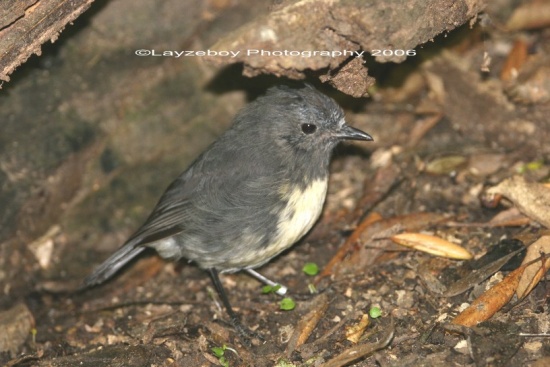
Photo © by Layzeboy
Motuara Island Bird Sanctuary, South Island, New Zealand, 25 February 2006
- Petroica australis
Identification

Photo © by Ornitho26
Cascade Creek, Fiordland National Park, South Island, New Zealand, 1 December 2005
18 cm (7 ins) 35 gm (1.13 ozs)
- Sooty grey head, neck and upperparts
- Faint pale grey wingbar
- Sooty grey tail with brownish tinge
- Slate-black chin and upper breast
- White lower breast and belly and undertail-coverts
- rakiura with more white on underparts
Females are similar to males, but upperparts, throat and flanks slightly paler.
Distribution
An uncommon endemic found on South Island, New Zealand
Taxonomy
Two subspecies recognized[1][2][3]:
- P. a. australis on South Island
- P. a. rakiura on Stewart Island
Formerly considered conspecific with North Island Robin under the name New Zealand Robin.
Habitat
Native and exotic forest
Behaviour
Long legs and an upright stance, inquisitive - almost appears tame
Perches on low branches and flies down to the forest floor - hops
Diet
Diet includes insects.
Breeding
Breeding : July-Jan
Vocalisation
Male has a loud clear song with regional differences - a string of phrases, including pwee-pwee-pwee, usually descending.Call is a soft chirp.
Recorded by Andrew Whitehouse
In Culture
Maori name: Toutouwai
References
- Clements, J. F., T. S. Schulenberg, M. J. Iliff, S. M. Billerman, T. A. Fredericks, B. L. Sullivan, and C. L. Wood. 2019. The eBird/Clements Checklist of Birds of the World: v2019. Downloaded from http://www.birds.cornell.edu/clementschecklist/download/
- Gill, F & D Donsker (Eds). 2018. IOC World Bird List (v8.2). doi : 10.14344/IOC.ML.8.2. Available at http://www.worldbirdnames.org/
- Christidis et al. 2018. The Howard and Moore Complete Checklist of the Birds of the World, version 4.1 (Downloadable checklist). Accessed from https://www.howardandmoore.org.
- Miller, Hilary C.; Lambert, David M. (2006). "A molecular phylogeny of New Zealand's Petroica (Aves: Petroicidae) species based on mitochondrial DNA sequences". Molecular Phylogenetics and Evolution. 40 (3): 844–855. https://doi:10.1016/j.ympev.2006.04.012.
- Higgins , P.J .; & Peter, J.M. (editors) 2002 . Handbook of Australian , New Zealand & Antarctic Birds. Volume 6 , Pardalotes to shrike-thrushes. Melbourne, Oxford University Press. [Vol. 5, pages 51-55] Vol. 6, pages 575-577 , 706-725; plate 18.
- Jobling, J. A. (2017). Key to Scientific Names in Ornithology. In: del Hoyo, J., Elliott, A., Sargatal, J., Christie, D.A. & de Juana, E. (eds.) (2017). Handbook of the Birds of the World Alive. Lynx Edicions, Barcelona. (retrieved from http://www.hbw.com).
- Powlesland, R.G. 2013. South Island robin. In Miskelly, C.M. (ed.) New Zealand Birds Online. http://www.nzbirdsonline.org.nz
Recommended Citation
- BirdForum Opus contributors. (2024) South Island Robin. In: BirdForum, the forum for wild birds and birding. Retrieved 26 May 2024 from https://www.birdforum.net/opus/South_Island_Robin




